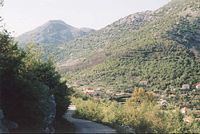 | ||
Skadarska Krajina (Montenegrin and Serbian Cyrillic: Скадарска Крајина, "Skadar Frontier"), known simply as Krajina (Крајина, pronounced [krâjina]; Albanian: Kraja) is a geographical region in southeastern Montenegro stretching from the southern coast of Lake Skadar to the mountain of Rumija, comprising several villages. It is inhabited mainly by Albanians and Montenegrins. The area is divided between the municipalities of Bar and Ulcinj.
Contents
Albanian Catholic priest, and author of the oldest published Albanian book, Gjon Buzuku was born in the village of Ljare in Kraja. Based on the last parts of the Priest of Duklja, Krajina was a political centre of Duklja. Jovan Vladimir, the ruler of Duklja (ca. 1000–1016), was interred in the Prečista Krajinska church by his widow Kosara, who also was buried in the church.
Geography
The region within Montenegro is located from the eastern border with Albania near the coast of the Adriatic Sea. It is located between Crmnica and Ana Malit regions and stretches out from Ckla village to Šestani, a sub-region often considered as forming part of wider region of Krajina. It is also between Skadar Lake and the Rumija mountain. Within Montenegro, it mainly consists of villages and small hamlets with Ostros being its most populated settlement (Pop. 230 (2003)). Within Albania, the region of Krajina is bordered on the southern flank by the Tarabosh mountains and only encompasses the coastal village of Zogaj on Lake Skadar.
Within Montenegro, Krajina encompasses some of the following villages and hamlets:
Šestani
Šestani (Albanian: Shestan, Serbian Cyrillic: Шестани) is a sub-region within Skadarska Krajina, in southernmost Montenegro. The region is a small mountain plateau of which terrace slopes towards the Skadar Lake.
Šestani was a tribe in the nahiya of Bar. According to tradition, the Albanian tribe of Šestani had settled the villages of Šestani, Livari and Briska (now Gornja Briska and Donja Briska) from Shkreli area around north-east of Shkodër (modern Albania) in the Ottoman period.
The Arbanasi people in the Zadar region are thought to have hailed from the villages of Briska (Brisk), Šestan (Shestan), Livari (Ljare), and Podi (Pod) having settled the Zadar area in 1726–27 and 1733 on the decision of Archbishop Vicko Zmajević of Zadar, in order to repopulate the land.
The region was divided into two, and in 1876, Gornji Šestani encompassed the villages of Lukići (Lukaj), Dedići (Dedaj), Marvučići (Rud), Gurza (Gurrëzë) and Barlovići (Bardhaj), while Donji Šestani encompassed Ðuravci (Gjuraç), Karanikići (Nrekaj, Nenmal), Draçevica (Pecaj), Marstijepovići (Bujgër) and Vučedabići (Uçdabaj),. In 1857, Šestani was inhabited by 579 people.
Šestan is a sub-region and an extension of Krajina, encompassing some of the following villages and hamlets:
Families of Shestan-Kraja
Skje
Arbënesh
Ostros
Qyrjan
Vëliq
Madgushë
Martiq
Sjerç
Runj
Bobosht
Blac
Kështenjë
Dragoviq
Ftjani
Brisk
Dobrec
Ljare
Besë
Muriq
Pinç
Demographics
From the late 1960s to the early 1970s, thousands of locals migrated to countries throughout Europe and to the United States. Between 2,000 and 3,000 people are estimated to live in the Krajina region, with a majority of ethnic Albanians. The religious make-up is Muslim and Christian (Eastern Orthodox and Roman Catholic). Christians mostly reside in the Shestan region, with minorities in Livari, Briska and Tejani.
